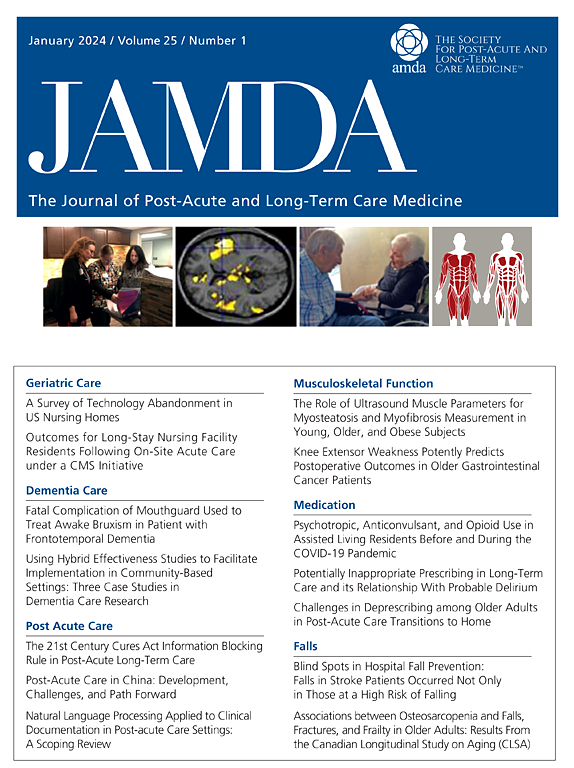Nursing Home Staffing Variability and Quality: Assessing Alternative Measures of Daily Staffing Level Variation
IF 4.2
2区 医学
Q2 GERIATRICS & GERONTOLOGY
Journal of the American Medical Directors Association
Pub Date : 2025-03-11
DOI:10.1016/j.jamda.2025.105532
引用次数: 0
Abstract
Objectives
Variability in daily nursing staffing levels is an important factor associated with nursing home quality and has led to calls to incorporate it in the Centers for Medicare and Medicaid’s staffing star rating calculation. This study assessed 6 distinct daily staffing level variation measures for their validity in explaining quality outcomes to determine an optimal variation measure for inclusion in the CMS staffing star rating.
Design
Analysis of secondary data.
Setting and Participants
The study analyzed data from the CMS Care Compare archives and Payroll-Based Journal for 2022Q1 to 2023Q3 and included 42,228 to 62,180 nursing home–quarter observations.
Methods
Six measures of daily staffing level variation, including the coefficient of variation (CV), total outlier days (TOD), low outlier days (LOD), coefficient of quartile variation (CQV), the mean coefficient of dispersion of the median absolute deviation (mean-CDMAD), and median coefficient of dispersion of the median absolute deviation (median-CDMAD) were each evaluated for statistical validity based on desirable properties using linear regression to evaluate their relationship with 9 patient-based nursing home quality outcomes. Performance was analyzed by assessing statistical significance and direction of correlation, goodness of fit, and monotonicity.
Results
The measure median-CDMAD demonstrated superior statistical properties, including the best goodness of fit in 56% to 67% of quality outcomes and consistency with the predicted direction in 51% to 89% of cases. Median-CDMAD, mean-CDMAD, and CV also demonstrated superior performance for monotonicity, indicating they are more robust against outliers and greater resistance to potential gaming by nursing homes than the other staffing level variation measures evaluated.
Conclusion and Implications
Median-based variation measures, particularly median-CDMAD, exhibit the greatest validity relative to nursing home quality outcomes, making them suitable for CMS's staffing star rating system. Incorporating daily staffing level variation can improve public information on staffing consistency and incentivize quality improvement in nursing homes.
目的:日常护理人员配置水平的变化是影响疗养院质量的一个重要因素,因此有人呼吁将其纳入医疗保险和医疗补助中心的人员配置星级评定计算中。本研究评估了 6 种不同的日常人员配置水平差异测量方法,以确定其在解释质量结果方面的有效性,从而确定最佳的差异测量方法,将其纳入 CMS 人员配置星级评定中:设计:二手数据分析:研究分析了 2022Q1 至 2023Q3 的 CMS Care Compare 档案和基于薪资的期刊数据,包括 42,228 至 62,180 个疗养院季度观察数据:采用线性回归方法,基于理想属性对每日人员配置水平变化的六项指标(包括变异系数 (CV)、总离群日 (TOD)、低离群日 (LOD)、四分位变异系数 (CQV)、中位数绝对偏差的平均离散系数 (mean-CDMAD) 和中位数绝对偏差的中位数离散系数 (median-CDMAD) )进行了统计有效性评估,以评估它们与 9 项基于患者的疗养院质量结果之间的关系。通过评估相关性的统计意义和方向、拟合度和单调性来分析其性能:结果:测量中位数-CDMAD 显示出卓越的统计特性,包括在 56% 至 67% 的质量结果中具有最佳拟合度,在 51% 至 89% 的案例中与预测方向一致。中位数-CDMAD、平均值-CDMAD 和 CV 在单调性方面也表现出色,这表明它们与其他被评估的人员配置水平变化测量方法相比,更能抵御异常值,也更能抵御养老院的潜在博弈:基于中位数的变化测量,尤其是中位数-CDMAD,在养老院质量结果方面表现出最大的有效性,使其适用于 CMS 的人员配置星级评定系统。将每日人员配置水平变化纳入其中可以提高公众对人员配置一致性的认识,并激励疗养院提高质量。
本文章由计算机程序翻译,如有差异,请以英文原文为准。
求助全文
约1分钟内获得全文
求助全文
来源期刊
CiteScore
11.10
自引率
6.60%
发文量
472
审稿时长
44 days
期刊介绍:
JAMDA, the official journal of AMDA - The Society for Post-Acute and Long-Term Care Medicine, is a leading peer-reviewed publication that offers practical information and research geared towards healthcare professionals in the post-acute and long-term care fields. It is also a valuable resource for policy-makers, organizational leaders, educators, and advocates.
The journal provides essential information for various healthcare professionals such as medical directors, attending physicians, nurses, consultant pharmacists, geriatric psychiatrists, nurse practitioners, physician assistants, physical and occupational therapists, social workers, and others involved in providing, overseeing, and promoting quality

 求助内容:
求助内容: 应助结果提醒方式:
应助结果提醒方式:


